How Do Fossils End Up In Rocks? Fossils, the preserved remains or traces of ancient life, offer a captivating window into Earth’s history, and at rockscapes.net we can help you understand this process better. Understanding how fossils end up in rocks involves a fascinating interplay of geological processes, from sedimentation to mineralization, and rockscapes.net is here to guide you through it. Discover the types of fossilization and rock formations today.
1. What Exactly is a Fossil?
A fossil is any preserved evidence of past life. These remains can range from bones and teeth to shells, footprints, and even fossilized dung, also known as coprolites.
- Body Fossils: These include preserved remains such as bones, teeth, shells, and other physical parts of an organism.
- Trace Fossils: These are indirect evidence of life, such as footprints, burrows, or coprolites, providing insights into the behavior and activities of ancient organisms.
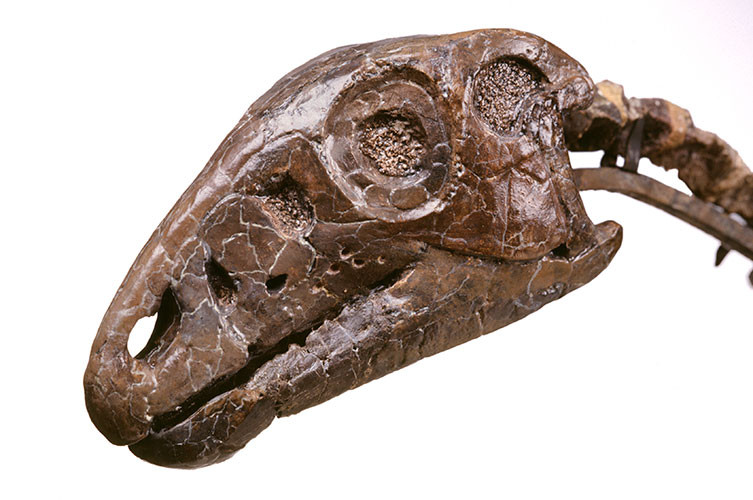 Hypsilophodon skull
Hypsilophodon skull
2. What Conditions Are Necessary for Fossilization?
Not every living thing becomes a fossil. Fossilization is a rare occurrence that requires specific conditions to occur.
- Rapid Burial: Quick burial by sediment, such as mud, sand, or volcanic ash, is crucial. This protects the organism from scavengers and decomposition.
- Anoxic Environment: A lack of oxygen slows down decomposition, increasing the chances of preservation.
- Hard Parts: Organisms with hard parts like bones, shells, or teeth are more likely to fossilize than those with only soft tissues.
- Sediment Type: Fine-grained sediments like silt and clay can preserve more detail than coarser sediments like sand and gravel.
According to research from Arizona State University’s School of Earth and Space Exploration, rapid burial in oxygen-poor environments significantly increases the likelihood of fossilization by minimizing decomposition.
3. Which Environments are Most Likely to Yield Fossils?
Fossils are more commonly found in specific environments that favor preservation.
- Marine Environments: The sea is a prime location for fossil formation due to the abundance of sediment and the presence of many organisms with hard shells and skeletons.
- Lakes and Rivers: Freshwater environments near rivers and lakes can also provide the necessary conditions for rapid burial and fossilization, especially during flood events.
- Volcanic Areas: Volcanic ash can quickly bury and preserve organisms, creating detailed fossils, as seen in sites like the Pompeii fossil beds.
- Caves: Caves can offer stable, sheltered environments where remains are protected from the elements, leading to exceptional preservation.
 Baryonyx claw
Baryonyx claw
4. How Does Petrification Turn Organic Matter Into Stone?
Petrification is one of the most common processes by which fossils form. It involves the replacement of organic material with minerals.
- Death and Burial: An organism dies and is quickly buried by sediment.
- Decomposition: Soft tissues decompose, leaving behind hard parts like bones and teeth.
- Sedimentation: Layers of sediment accumulate, compressing the lower layers into sedimentary rock.
- Mineralization: Water containing dissolved minerals seeps through the sediment and into the bones. The minerals precipitate out of the water, gradually replacing the organic material of the bone with stone.
This process can take thousands to millions of years, resulting in a fossil that retains the shape and structure of the original organism. David Button, a dinosaur researcher at the Natural History Museum, notes that this mineralization often preserves the internal bone structure, giving fossils a sponge-like texture.
5. What Are Mould and Cast Fossils?
Mould and cast fossils are formed when an organism leaves an impression in sediment, which is then filled with minerals.
- Mould Fossils: These form when the original organism dissolves away, leaving a hollow imprint in the surrounding rock.
- Cast Fossils: These form when the mould is filled with minerals or sediment, creating a replica of the original organism.
These types of fossils are common among marine animals with shells, such as ammonites and bivalves. The Natural History Museum highlights that trace fossils like footprints also form similarly, with the footprint acting as a mould that is later filled.
6. How Does Uplift and Erosion Expose Fossils?
Fossils are often buried deep within layers of rock. Uplift and erosion work together to bring these fossils to the surface.
- Uplift: Tectonic plate movements can cause rock layers to be pushed upwards, forming mountains and exposing previously buried sediments. According to the U.S. Geological Survey, the collision of tectonic plates is responsible for the uplift of the Himalayas, where marine fossils have been found at high altitudes.
- Weathering: Wind, rain, ice, and temperature changes break down rock, gradually exposing any fossils within.
- Erosion: Rivers and streams carry away sediment, further revealing fossils.
David Button explains that these processes take millions of years, but eventually, fossils become exposed at the surface, ready to be discovered.
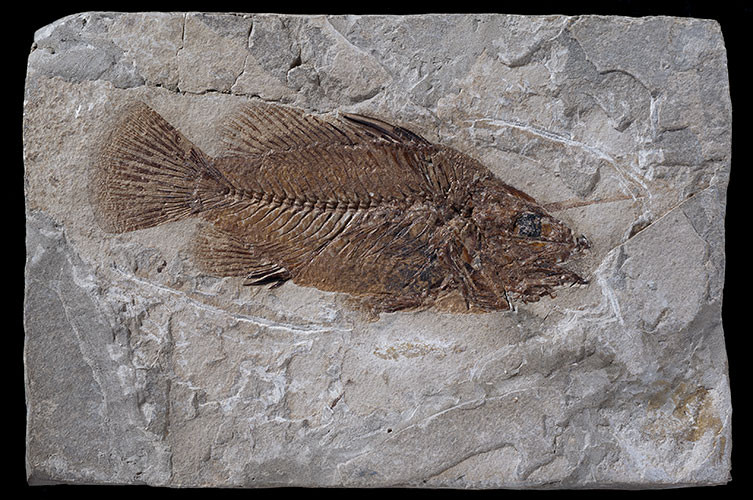 Fossil fish
Fossil fish
7. How Do Paleontologists Find Fossils?
Paleontologists use a variety of techniques to locate and excavate fossils.
- Geological Surveys: Identifying areas with sedimentary rock formations that are likely to contain fossils.
- Surface Surveys: Walking through promising areas and looking for exposed fossils or fragments.
- Excavation: Carefully removing rock and sediment to uncover fossils, using tools like shovels, picks, and brushes.
- Screen Washing: Sifting through sediment to find small fossils or bone fragments.
- Documentation: Recording the location and orientation of each fossil to understand its context.
The University of California Museum of Paleontology emphasizes the importance of meticulous documentation to preserve the scientific value of fossil discoveries.
8. What Can Fossils Tell Us About the Past?
Fossils provide invaluable insights into Earth’s history, including:
- Evolution: Fossils document the evolution of life over millions of years, showing how organisms have changed and adapted.
- Climate: Fossils can indicate past climate conditions, such as temperature and rainfall, based on the types of plants and animals that lived in a particular area.
- Ecosystems: Fossils reveal the composition and structure of ancient ecosystems, showing how different species interacted.
- Geological Events: Fossils can help date rock layers and understand geological events like volcanic eruptions and sea-level changes.
9. What Types of Fossils Can Be Found in the USA?
The United States is rich in fossil deposits, with a wide variety of fossils found across the country.
- Dinosaur Fossils: The western states, such as Montana, Wyoming, and Colorado, are famous for dinosaur fossils, including Tyrannosaurus Rex and Triceratops.
- Marine Fossils: Coastal areas and states like Florida and California are rich in marine fossils, including shells, corals, and marine reptiles.
- Plant Fossils: Petrified wood is common in states like Arizona and Oregon, with stunning examples found in Petrified Forest National Park.
- Ice Age Fossils: Fossils of mammoths, saber-toothed cats, and other Ice Age mammals have been found in states like California and Florida.
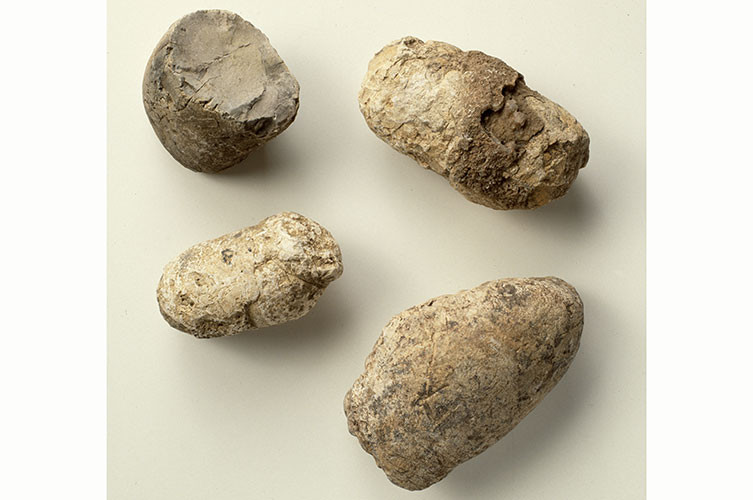 Four dinosaur coprolites
Four dinosaur coprolites
10. How Do Trace Fossils Provide Clues About Ancient Life?
Trace fossils, while not the remains of an organism itself, offer valuable information about its behavior and environment.
- Footprints: Provide information about the size, weight, and gait of an animal. They can also reveal social behaviors if multiple sets of footprints are found together.
- Burrows: Indicate the presence of burrowing animals and their lifestyle.
- Coprolites: Fossilized dung can reveal the diet of an animal. Analyzing coprolites can identify plant and animal remains, providing insights into the food chain.
- Bite Marks: Tooth marks on bones can show predator-prey relationships.
11. How Does Climate Change Affect Fossil Preservation?
Climate change can impact fossil preservation in several ways.
- Erosion: Increased rainfall and extreme weather events can accelerate erosion, potentially destroying exposed fossils.
- Sea Level Rise: Rising sea levels can inundate coastal fossil sites, leading to their destruction.
- Permafrost Thaw: Thawing permafrost can expose previously frozen fossils but also lead to their rapid decomposition.
- Acid Rain: Increased acidity in rainwater can dissolve fossils, especially those made of calcium carbonate.
Understanding these impacts is crucial for preserving fossil sites and the information they hold.
12. What Role Does Sedimentary Rock Play in Fossil Formation?
Sedimentary rock is essential for fossil formation because it provides the environment for burial and preservation.
- Formation: Sedimentary rocks are formed from layers of sediment that accumulate over time. These sediments can include sand, mud, silt, and organic material.
- Burial: As sediment layers build up, they bury and protect organic remains from scavengers and decomposition.
- Compression: The weight of overlying sediments compresses the lower layers into solid rock.
- Mineralization: Water seeping through the sediment deposits minerals that replace organic material, turning it into stone.
Common types of sedimentary rocks that contain fossils include sandstone, shale, and limestone.
13. Can Soft Tissues Be Fossilized?
While rare, soft tissues can be fossilized under exceptional conditions.
- Exceptional Preservation: Some fossil sites, known as Lagerstätten, preserve soft tissues in remarkable detail. These sites often have unique environmental conditions that prevent decomposition.
- Rapid Burial: Quick burial in fine-grained sediment can protect soft tissues from scavengers and oxygen.
- Anoxic Conditions: A lack of oxygen slows down decomposition, allowing soft tissues to be preserved.
- Mineralization: Minerals can quickly infiltrate and replace soft tissues, creating detailed fossils.
Examples of soft tissue fossils include insects in amber, mammoths frozen in permafrost, and jellyfish preserved in shale.
14. What Are Some Famous Fossil Sites in the World?
Several fossil sites around the world are famous for their exceptional fossil discoveries.
- Burgess Shale (Canada): Known for its well-preserved Cambrian fossils, including soft-bodied organisms.
- Messel Pit (Germany): A former oil shale quarry that preserves a wide variety of Eocene fossils, including mammals, birds, and insects.
- Dinosaur Provincial Park (Canada): A UNESCO World Heritage Site with numerous dinosaur fossils from the Late Cretaceous period.
- Yixian Formation (China): Famous for its feathered dinosaur fossils, providing insights into the evolution of birds.
- La Brea Tar Pits (USA): Located in Los Angeles, these tar pits have preserved thousands of Ice Age mammals, including saber-toothed cats and mammoths.
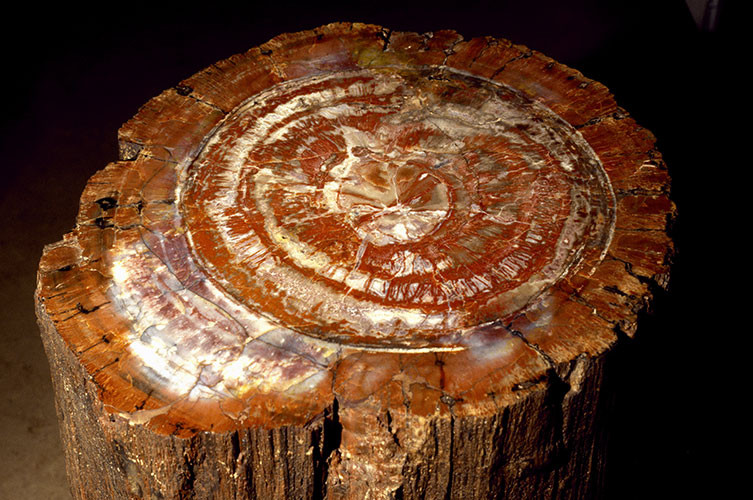 Petrified tree trunk
Petrified tree trunk
15. How Do Fossils Help Us Understand Extinction Events?
Fossils provide crucial evidence for understanding extinction events, both large and small.
- Fossil Record: The fossil record shows the appearance and disappearance of species over time, allowing scientists to identify periods of rapid extinction.
- Causes of Extinction: By studying the fossils and the rocks in which they are found, scientists can infer the causes of extinction events, such as climate change, volcanic eruptions, or asteroid impacts.
- Recovery After Extinction: Fossils also reveal how life recovers after extinction events, showing which species survived and how new species evolved to fill ecological niches.
The Cretaceous-Paleogene extinction event, which wiped out the dinosaurs, is one of the most well-studied extinction events in the fossil record.
16. What Are Index Fossils and How Are They Used?
Index fossils are specific fossils used to define and identify geologic periods.
- Definition: Index fossils are widespread, abundant, and existed for a relatively short period. Their presence in a rock layer indicates the age of that layer.
- Examples: Common index fossils include ammonites, trilobites, and certain types of microfossils.
- Use in Dating: By identifying index fossils in different rock layers, geologists can correlate the ages of those layers, even if they are located in different parts of the world.
Index fossils are essential tools for creating a global geologic timescale.
17. How Do Tectonic Plates Influence Fossil Distribution?
Tectonic plate movements can significantly affect the distribution of fossils around the world.
- Continental Drift: The movement of tectonic plates can separate landmasses, leading to the isolation and unique evolution of species. Fossils can provide evidence for these past connections.
- Mountain Building: The collision of tectonic plates can uplift rock layers, exposing fossils that were once buried deep within the Earth.
- Subduction Zones: At subduction zones, one tectonic plate slides beneath another, potentially destroying fossils in the process.
The distribution of dinosaur fossils, for example, reflects the positions of continents during the Mesozoic Era.
18. What is the Significance of Lagerstätten Fossil Sites?
Lagerstätten are fossil sites with exceptional preservation, often including soft tissues and detailed anatomical features.
- Exceptional Preservation: Lagerstätten preserve fossils in remarkable detail, providing insights into the anatomy and ecology of ancient organisms that are rarely seen in typical fossil sites.
- Examples: Famous Lagerstätten include the Burgess Shale, the Messel Pit, and the Solnhofen Limestone.
- Scientific Value: These sites offer a unique window into the history of life, revealing the diversity and complexity of ancient ecosystems.
19. What Ethical Considerations Are Involved in Fossil Collecting?
Fossil collecting involves several ethical considerations to ensure responsible and sustainable practices.
- Permits and Regulations: Many areas require permits for fossil collecting. It is essential to comply with local, state, and federal regulations.
- Private vs. Public Land: Collecting fossils on private land requires permission from the landowner. On public land, there may be restrictions on collecting.
- Scientific Value: Fossils with scientific value should be donated to museums or research institutions, where they can be studied and preserved for future generations.
- Commercial Collecting: The commercial sale of fossils raises ethical concerns about the potential for over-collecting and damage to fossil sites.
20. How Can Citizen Scientists Contribute to Paleontology?
Citizen scientists can play a valuable role in paleontology by participating in various activities.
- Fossil Reporting: Reporting fossil finds to local museums or research institutions.
- Volunteering: Assisting with fossil excavation and preparation in museums or field sites.
- Data Collection: Participating in online projects to analyze and classify fossil images.
- Education and Outreach: Sharing knowledge about fossils and paleontology with the public.
The Paleontological Society encourages citizen scientists to get involved in paleontology and contribute to the understanding of Earth’s history.
21. What New Technologies Are Being Used in Paleontology?
New technologies are revolutionizing paleontology, allowing scientists to study fossils in unprecedented detail.
- CT Scanning: Computed tomography (CT) scanning creates detailed 3D images of fossils, allowing scientists to study their internal structure without damaging the specimens.
- 3D Printing: 3D printing allows scientists to create replicas of fossils for study and display.
- DNA Analysis: Analyzing ancient DNA extracted from fossils can provide insights into the genetic relationships and evolution of extinct organisms.
- Microscopy: Advanced microscopy techniques allow scientists to study the microscopic details of fossils, including soft tissues and cellular structures.
These technologies are transforming the field of paleontology and leading to new discoveries about the history of life.
22. How Do Fossils Help Us Understand the Evolution of Humans?
Fossils play a crucial role in understanding human evolution by providing direct evidence of our ancestors and their way of life.
- Hominin Fossils: Fossils of hominins, the group that includes humans and our extinct relatives, document the evolution of our lineage over millions of years.
- Key Discoveries: Famous hominin fossils include Australopithecus afarensis (Lucy), Homo habilis, and Homo erectus.
- Evolutionary Trends: Fossils reveal key evolutionary trends in human evolution, such as increasing brain size, bipedalism, and tool use.
- Geographic Distribution: Fossil discoveries show the geographic distribution of early humans and their migration patterns.
The Smithsonian National Museum of Natural History has extensive collections of hominin fossils that provide insights into human origins.
23. How Can Fossils Be Used in Education and Outreach?
Fossils are powerful tools for education and outreach, engaging people of all ages in learning about science and the natural world.
- Museum Exhibits: Fossil exhibits in museums bring the past to life, showcasing the diversity of ancient life and the process of fossilization.
- Educational Programs: Schools and museums offer educational programs about fossils and paleontology, teaching students about evolution, geology, and scientific inquiry.
- Fossil Digs: Participating in fossil digs provides hands-on learning experiences and allows people to contribute to scientific research.
- Online Resources: Websites and virtual museums offer a wealth of information about fossils, making it accessible to a global audience.
24. What Role Do Museums Play in Fossil Preservation and Research?
Museums play a vital role in preserving, studying, and displaying fossils.
- Collection and Preservation: Museums collect and preserve fossils, ensuring their long-term protection.
- Research: Scientists at museums conduct research on fossils, studying their anatomy, evolution, and ecology.
- Exhibits and Education: Museums create exhibits that showcase fossils and educate the public about paleontology.
- Public Access: Museums provide public access to fossil collections, allowing people to learn about the history of life on Earth.
The American Museum of Natural History and the Smithsonian National Museum of Natural History are leading institutions in fossil research and education.
25. How Do Fossils Help Us Understand Past Climate Change?
Fossils serve as valuable indicators of past climate conditions, providing insights into long-term climate trends and changes.
- Plant Fossils: The types of plants preserved in fossils can indicate past temperature and rainfall patterns. For example, fossils of tropical plants in high-latitude regions suggest warmer climates in the past.
- Animal Fossils: The distribution of animal fossils can also reveal past climate conditions. For example, fossils of marine organisms in inland areas indicate past sea-level changes.
- Isotope Analysis: Analyzing the isotopes in fossils can provide information about past temperatures and precipitation.
- Pollen Analysis: Studying fossilized pollen grains can reveal changes in vegetation patterns over time, reflecting changes in climate.
By studying fossils, scientists can reconstruct past climate conditions and understand how climate change has affected life on Earth.
26. How Can You Start Your Own Fossil Collection?
Starting your own fossil collection can be a rewarding hobby.
- Research Local Fossil Sites: Find out about fossil sites in your area and the types of fossils that can be found there.
- Join a Fossil Club: Connect with other fossil enthusiasts and learn about collecting techniques and ethics.
- Obtain Permits: Make sure you have the necessary permits for collecting fossils in your area.
- Collect Responsibly: Collect fossils ethically and sustainably, respecting private property and leaving the site as you found it.
- Identify and Label Your Fossils: Learn how to identify and label your fossils, keeping track of where and when you found them.
27. How Do Scientists Determine the Age of Fossils?
Scientists use various methods to determine the age of fossils.
- Relative Dating: Relative dating techniques compare the age of a fossil to the age of surrounding rocks.
- Radiometric Dating: Radiometric dating techniques measure the decay of radioactive isotopes in fossils and rocks to determine their age.
- Carbon Dating: Carbon dating is used to date organic materials up to around 50,000 years old.
- Potassium-Argon Dating: Potassium-argon dating is used to date volcanic rocks and can be used to date fossils found in volcanic ash layers.
These dating methods allow scientists to construct a timeline of life on Earth.
28. How Do Fossils Support the Theory of Evolution?
Fossils provide strong evidence for the theory of evolution by documenting the gradual changes in organisms over time.
- Transitional Fossils: Transitional fossils show intermediate forms between ancestral and descendant species, illustrating the process of evolution.
- Fossil Record: The fossil record shows the sequence of life on Earth, with simpler organisms appearing earlier and more complex organisms appearing later.
- Homologous Structures: Fossils reveal homologous structures, such as the bones in the limbs of different vertebrates, which share a common ancestry.
- Vestigial Structures: Fossils show vestigial structures, such as the reduced limbs in snakes, which are remnants of ancestral features.
29. How Does Fossilization Differ for Plants Compared to Animals?
Fossilization can differ for plants and animals due to their different compositions and environments.
- Plant Fossils: Plant fossils often include leaves, stems, roots, and reproductive structures. Plant tissues can be preserved through compression, impression, or petrification.
- Animal Fossils: Animal fossils typically include bones, teeth, shells, and other hard parts. Animal tissues can be preserved through petrification, permineralization, or exceptional preservation.
- Environment: Plants are often fossilized in terrestrial environments, while animals can be fossilized in both terrestrial and aquatic environments.
30. How Can Fossils Be Used to Reconstruct Ancient Ecosystems?
Fossils provide valuable information for reconstructing ancient ecosystems.
- Species Composition: Fossils reveal the types of plants and animals that lived in a particular area.
- Food Webs: Analyzing fossils can reveal the relationships between species, such as predator-prey interactions and food sources.
- Habitat Reconstruction: The types of fossils found in a particular area can indicate the type of habitat that existed there, such as forests, grasslands, or aquatic environments.
- Climate Reconstruction: Fossils can provide information about past climate conditions, such as temperature and rainfall.
By studying fossils, scientists can create detailed reconstructions of ancient ecosystems, providing insights into the interactions between species and their environment.
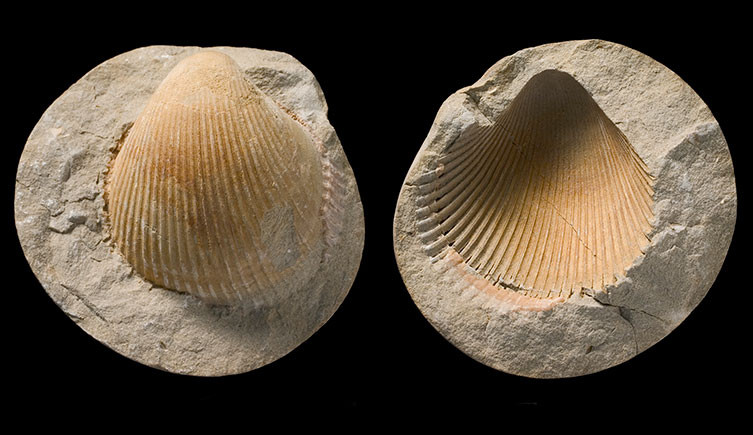 Bivalve shell fossils
Bivalve shell fossils
Ready to explore the fascinating world of fossils and rockscapes? Visit rockscapes.net for inspiration, information, and expert advice on incorporating natural stone into your landscape. Discover the beauty and durability of natural stone for your next project. Contact us at 1151 S Forest Ave, Tempe, AZ 85281, United States or call +1 (480) 965-9011.
FAQ: Frequently Asked Questions About Fossils and Rocks
- What is the most common type of fossil?
The most common fossils are those of marine invertebrates with hard shells, like shellfish and corals. - Can fossils be found in all types of rock?
Fossils are primarily found in sedimentary rocks because of how these rocks form through the accumulation of sediments. - How long does it take for a fossil to form?
The fossilization process can take thousands to millions of years, depending on the conditions and the type of organism. - What is the difference between a paleontologist and a geologist?
Paleontologists study ancient life through fossils, while geologists study the Earth’s structure, materials, and processes. - How do scientists know the color of dinosaurs?
Scientists infer dinosaur colors by studying melanosomes, pigment-containing structures preserved in some fossil feathers and skin. - What should I do if I find a fossil?
Document its location, take photos, and report it to a local museum or geological survey, especially if it’s a significant find. - Are there laws protecting fossils on public lands?
Yes, in the U.S., the Paleontological Resources Preservation Act (PRPA) protects fossils on federal lands, requiring permits for collection. - How are fossils prepared for study?
Fossils are prepared using tools like air scribes, dental picks, and chemicals to remove surrounding rock without damaging the fossil. - Can climate change affect fossil preservation?
Yes, rising sea levels, increased erosion, and extreme weather events can damage or destroy fossil sites. - Where can I see dinosaur fossils in the USA?
Numerous museums across the USA, such as the Smithsonian National Museum of Natural History and the American Museum of Natural History, display dinosaur fossils.
By exploring these questions and resources, you can deepen your understanding of fossils and rocks, and appreciate the history they hold.